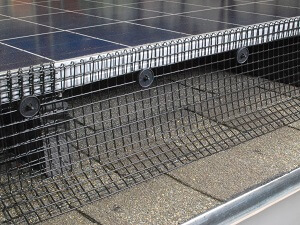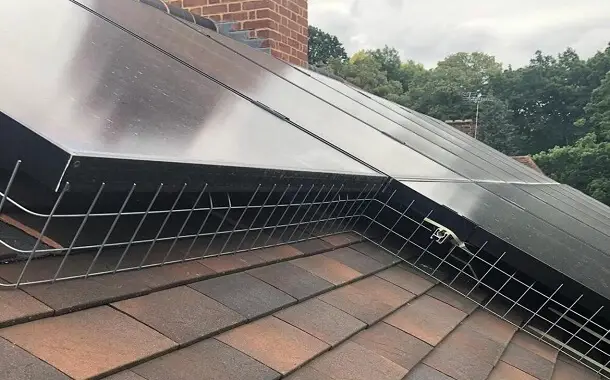Solar Panel Bird Proofing Cost
Owning solar panels is a big investment, and maintaining your solar panels is necessary to ensure your long-term benefits. Bird droppings can affect the performance of a panel to a greater extent than dust accumulation. Trees near your panels will not only drop their leaves and branches but will also attract birds. These cause bird droppings and debris over time, which will not only require cleaning but are also a safety hazard. Therefore, monthly or annual gutter cleaning and bird proofing may be required.
Solar panel bird proofing solutions and costs
There are many ways you can try to keep the birds away from your solar panels. Though we will go over the two best solutions, plus an extra deterrent you can go for to protect your solar panels without breaking the bank.
Bird spikes
The anti-bird tape is entirely made of stainless steel (the support and the spikes) and is used to prevent the birds from standing, moving, nesting, and dropping excrement on or close to your solar panels. The system is mounted with dowels/screws or silicone adhesive, depending on the support material. When mounting with adhesive, it is necessary to clean the surface on which the tape is mounted beforehand.
Using bird spikes comes with advantages, such as:
- excrement deposition is eliminated;
- the formation of nests is prevented;
- the corrosion of the protected metal surfaces is eliminated;
- the risk of infestation with intestinal parasites is reduced;
- the risk of contracting some diseases transmitted from animals to humans is reduced;
- very long duration of use;
- stainless steel does not react to aggressive atmospheric factors;
- after a certain period, the birds will definitively avoid the protected areas.
The cost of bird spikes
This is a relatively cheap solution for solar bird proofing and you will spend less than $17 for three-foot-long lengths. The cost to birdproof your solar panels for an average roof would be around $230. Though, these don’t have such a nice appearance and design.
Metal or netting mesh
A better alternative to bird spikes is metal/net mesh netting because it fully impedes the birds from accessing the panels. This will be installed over the solar panels, so the birds cannot land and get underneath the panels. However, these are harder to maintain and more expensive than bird spikes.
You might also like our articles on the cost of a windmill, solar panel maintenance, or GenerLink.
Cost of metal or netting mesh
Plan on spending anywhere between $320 and $550 to fully protect your solar panels against birds with these nets.
Replica predator
Another solution for solar panel bird proofing, which is more complementary to the ones mentioned above, is to install a replica predator statue on your roof. You might think that this is silly, but research has shown that birds are scared by the replica predators such as owls. However, birds can spot a fake predator rather quickly, but when it is combined with other deterring factors it can confuse the birds.
Cost of a replica predator
This is clearly the easiest and cheapest solution, but also the least effective. Expect to pay anywhere between $25 and $35 for a replica predator
So, what is the best way to bird-proof your solar panels?
We believe that one of the best ways to protect your solar panels against birds is mesh netting. Compared to the bird spikes, these are a little more expensive but are safer for the birds, more effective, and much more aesthetically pleasing. These block the access to the underside of the solar panels making birds less attracted to land on the roof.
But why do birds love solar panels so much?
 As a solar panel owner, it can be really frustrating to deal with the mess caused by birds, if you don’t take the needed precautions. The experts from Bird-B-Gone made a study regarding the reasons why birds are attracted to solar panels.
As a solar panel owner, it can be really frustrating to deal with the mess caused by birds, if you don’t take the needed precautions. The experts from Bird-B-Gone made a study regarding the reasons why birds are attracted to solar panels.
The main reason why birds like solar panels is the nice warmth it offers. In order to catch as much photovoltaic energy as possible, solar panels are dark in color. This color heats up easily and maintains its warmth for a longer time. So, the solar panels are the perfect place for the birds that are always looking for a warm spot where to rest and make their nests.
Another reason is they are seen as a shelter where the birds can raise their little chicks and protect them from predators. In general, solar panels have large gaps where the birds can create a shelter and be protected. Also, during the summer hot days, the shade offered by solar panels is very important for birds to control their body temperature.
Finally, birds like solar panels because it is very easy for them to get out of their housing. Most solar panels are installed on roofs offering birds a great viewpoint and a 360-degree movement away from their shelter. It is very important for birds to have a nest that is secure, safe, and easy to access.
Final words
To sum it up, if you are looking for a solution to protect your solar panels against the birds, there are two very good options: wire/mesh netting or bird spikes. Each of these comes with advantages and disadvantages, but, from what we could gather, the best one is netting. It is more effective, looks better, and is safer for the birds (they can get hurt in the spikes sometimes).
You can install both of these solar panel bird-proofing systems yourself and save some money. Though, if you want to hire a professional for this work, the cost will go up to a minimum of $1,100.
FAQs
How can I bird-proof my solar panels?
As you can see in the article, there are two better ways to bird-proof your solar panels. These are the wire mesh that impedes the birds to get in between the roof and the solar panels, and the bird spikes.
Are birds scared by solar panels?
No, solar panels do not scare birds. Actually, birds are attracted by them and this is why you have to bird-proof your solar panels.
How much does it cost to birdproof solar panels?
Bird-proofing solar panels will cost anywhere between $230 and $550, depending on the deterrent method you choose. The cost will also be affected by the number of solar panels and the size of the roof.


Leave a Reply
Want to join the discussion?Feel free to contribute!